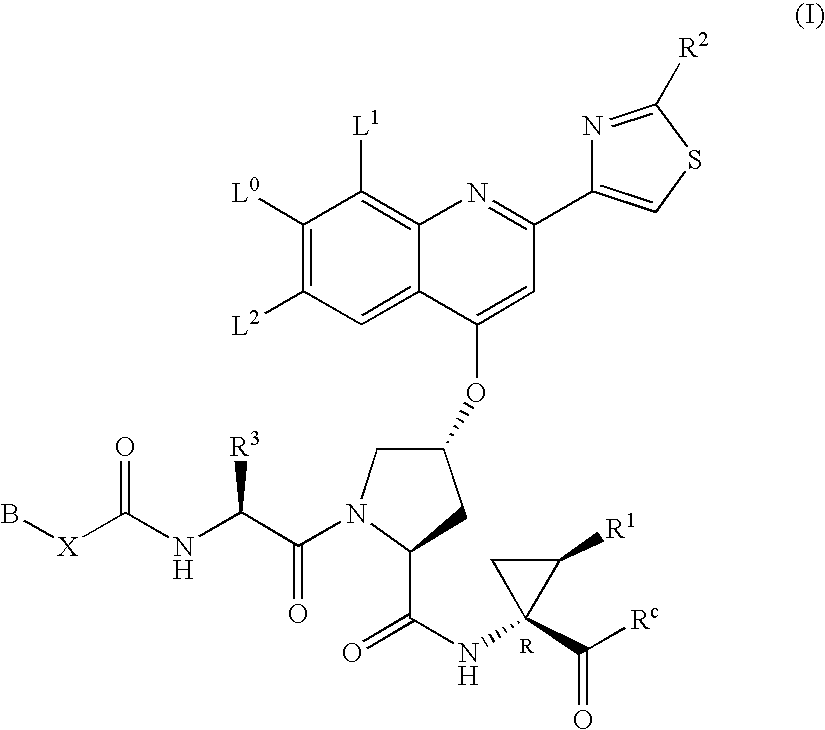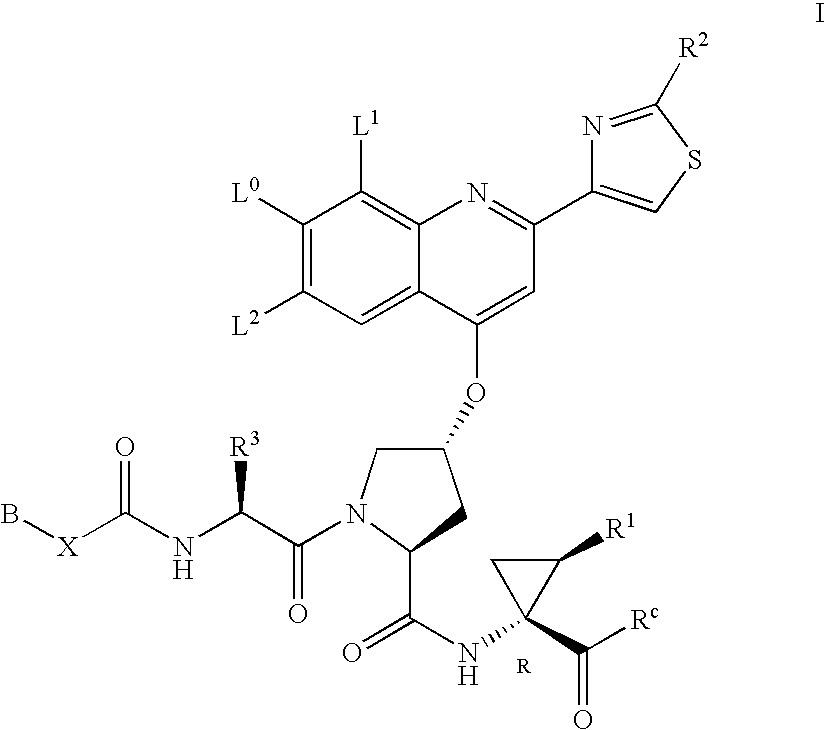Hepatitis C inhibitor compounds
a technology of hepatitis c and inhibitors, applied in the direction of antiinfective drugs, peptides, drug compositions, etc., can solve the problems of lack of effective immunoglobulin treatment, lack of cellular and humoral immune responses in protecting against hcv infection and disease, and the recommendation of immunoglobulin treatment, etc., to achieve the effect of higher plasma levels
- Summary
- Abstract
- Description
- Claims
- Application Information
AI Technical Summary
Benefits of technology
Problems solved by technology
Method used
Image
Examples
example 1
Synthesis of P3 Derivatives
Synthesis of Carbamate 4a
[0252]
[0253]THF (350 mL) was added to a flask containing carbonic acid cyclopentyl ester 2,5-dioxo-pyrrolidin-1-yl ester (9.00 g; 39.6 mmol) and tert-butyl glycine (6.24 g; 47.5 mmol) resulting in a suspension. Distilled water (100 mL) was added with vigorous stirring. A small amount of solid remained undissolved. Triethylamine (16.6 mL; 119 mmol) was then added resulting in a homogenous solution which was stirred at R.T. After 2.5 h, the THF was evaporated and the aqueous residue diluted with water (100 mL). The reaction was rendered basic by the addition of 1 N NaOH (25 mL−final pH>10). The solution was washed with EtOAc (2×200 mL) and the aqueous phase acidified with 1 N HCl (ca. 70 mL−final pH4) and evaporated to give carbamate 4a as a white solid (8.68 g).
Preparation of Ureas 5a
[0254]
[0255]A solution of tert-butyl glycine benzyl ester hydrochloride salt (2.55 g; 9.89 mmol) in THF (20 mL) and pyridine (2.0 mL; 24.73 mmol) was c...
example 2
Synthesis of Thioureas 8
Synthesis of thiourea 8a:
[0257]
[0258]To a solution of tert-butyl isothiocyanate (5.0 mL; 39.4 mmol.) in DCM (200 mL) was added cyclopentylamine (4.67 mL; 47.3 mmol.) followed by DIPEA and the reaction mixture was stirred at R.T. for 2 h. The mixture was diluted with EtOAc, and washed with a 10% aqueous solution of citric acid (2×), saturated NaHCO3 (2×), H2O (2×) and brine (1×). The organic layer was dried over anhydrous MgSO4, filtered and evaporated to yield N-tert-butyl-N′-cyclopentylthiourea as a white solid (3.70 g; 47% yield). The N-tert-butyl-N′-cyclopentylthiourea (3.70 g) was dissolved in concentrated HCl (46 mL). The dark yellow solution was heated at a gentle reflux. After 40 min the reaction mixture was allowed to cool to R.T. and thereafter cooled in ice and rendered basic to pH 9.5 with solid and a saturated aqueous solution of NaHCO3. The product was extracted into EtOAc (3×). The combined EtOAc extracts were washed with H2O (2×) and brine (1×)...
example 3a
Synthesis of 2-carbomethoxy4-hydroxy-7-methoxy-8-methylquinoline (A5)
Step A
[0264]
[0265]To a solution of 2-methyl-3-nitro anisole A1 (5.1 g; 30.33 mmol; requires ˜30 min to dissolve) in absolute ethanol (85 mL) was added 10% Pd / C catalyst (500 mg). The solution was hydrogenated under a hydrogen filled balloon at atmospheric pressure and room temperature for 19 h. The reaction mixture was filtered through a Celite pad, rinsed and evaporated to dryness to obtain 2-methyl-3-methoxyaniline A2 as a deep mauve oil (4.1 g; 29.81 mmol; 98% yield).
[0266]MS 137 (MH)+. Reverse Phase HPLC Homogeneity @ 220 nm (0.06% TFA; CH3CN:H2O): 99%.
Step B
[0267]
[0268]Dimethyl acetylene dicarboxylate A3 (3.6 mL, 29.28 mmol) was added dropwise to a solution of 2-methyl-3-methoxyaniline A2 (3.95 g, 28.79 mmol) in MeOH (100 mL) (reaction is exothermic). The mixture was heated at a gentle reflux for 5 hours cooled and concentrated under vacuum. The crude material was purified by flash column chromatography on sil...
PUM
| Property | Measurement | Unit |
|---|---|---|
| pH | aaaaa | aaaaa |
| temperature | aaaaa | aaaaa |
| temperature | aaaaa | aaaaa |
Abstract
Description
Claims
Application Information
 Login to View More
Login to View More - R&D
- Intellectual Property
- Life Sciences
- Materials
- Tech Scout
- Unparalleled Data Quality
- Higher Quality Content
- 60% Fewer Hallucinations
Browse by: Latest US Patents, China's latest patents, Technical Efficacy Thesaurus, Application Domain, Technology Topic, Popular Technical Reports.
© 2025 PatSnap. All rights reserved.Legal|Privacy policy|Modern Slavery Act Transparency Statement|Sitemap|About US| Contact US: help@patsnap.com



